
-Sports are stitched deeply in the fabric of American culture. So it feels natural that Americans would deeply love wearing the stitched fabric of their favorite sports teams. Fans love rocking fashionable gear of their favorite teams. Celebrities are no different. role team licensed sports apparel has played in pop culture, and the way figures in pop culture has influenced sports fan and what they wear.
It is hard to imagine now, but not long ago you’d rarely see someone wearing a sports hat and shirt of their favorite team. And that was at the stadium or in the arena to watch a game. Today, crowds are washed in a sea of home team colors from fans wearing their passion on their sleeves. If there’s anything I’m grateful for, it’s that I don’t have to dress like Tom Landry every time I go to a game as our forefathers did. Team licensed hats, jerseys and apparel are now in the closets of every home. In family homes they are typically referred to as “Fill-in-the-blank-person’s favorite fill-in-the-blank-team hat”. Our favorite team gear is the rare inanimate object we have real emotional connection with.
By adorning fan-wear of any type, people quickly communicate something to the world about themselves. A modern reminder of our tribalist roots. We wear it to show our allegiance and because it matches our sneakers. Or just because it’s the most comfortable thing in the closet. We wear fan gear to feel more like ourselves and more than ourselves at the same time. Like we are a part of the team or something. Talk to a fan about the team they are wearing and studies have shown you are 98% more likely to hear them use the pronoun “we” in their response.
These are the the clothes we wear during the happiest moments of our lives.
With the omnipresence of team sports product in our lives today, I am going to take a look back over the history of officially sports licensed team products. Who and what influenced the industry and how we use the products today.
Cultural influencers have driven the consumer choices of the masses for generations. The same has been true during the explosion of the sports licensing industry over the past 40 years. Many famous names have had a hand in shaping and influencing the global popularity of team licensed apparel, but few have actually created the industry.
It’s one thing to rock a Yankee hat on the streets of Manhattan -the way hundreds of celebs have seeking that pseudo-anonymous look of a dressed down Saturday at Central Park. It is quite another to have a direct hand in what millions wear on a daily basis. These four legends of the licensed sports industry used the familiar family looms of team logos as their pallet of expression. Some were conscious of how they were using these products to communicate and connect people across cultures and countries. Others, not so much. But they’re artistic vision and vibrant personalities organically created movements in the sports licensing industry over the past four decades.


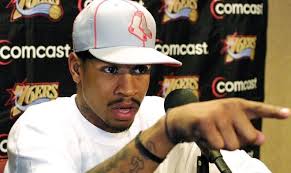
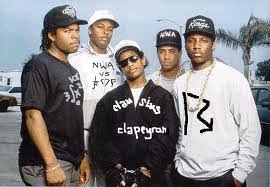
The list of influencers in this space over the years is long; from the worlds of show business, music, politics, sports and entertainment. But Spike Lee, Alyssa Milano, Allen Iverson and N.W.A., the group eponymous with gangsta rap, have touched the world of sports with their artistic vision, and in the process, changed the way we fan, and have created iconic products in the the sports fan wear world.
Spike Lee
 Spike Lee made his name as a polarizing director with some of the most controversial films of the 80’s & 90’s to his credit. Despite his achievements in the movie industry, most people know him best as both a super fan and a fashion trend-setter. Spike’s one of the attractions when visiting Madison Square Garden, serving as something of a living statue erected court side instead of outside. He is also the Father of custom 59/50 New Era headwear. When you think of Spike, the image in your mind has him donning a crisp New Era hat of one of his beloved New York teams; the Knicks, Yankees, or one of his favorites, the Brooklyn Dodgers.
Spike Lee made his name as a polarizing director with some of the most controversial films of the 80’s & 90’s to his credit. Despite his achievements in the movie industry, most people know him best as both a super fan and a fashion trend-setter. Spike’s one of the attractions when visiting Madison Square Garden, serving as something of a living statue erected court side instead of outside. He is also the Father of custom 59/50 New Era headwear. When you think of Spike, the image in your mind has him donning a crisp New Era hat of one of his beloved New York teams; the Knicks, Yankees, or one of his favorites, the Brooklyn Dodgers.
 While his passion is undeniable, and his fashion sense on point -Spike was the original Brooklyn hipster, before millennials were born- it wasn’t until he made a simple inquiry with New Era in 1996 that he left his mark on fans and fashionistas across the world. Spike was looking to match his headwear with a new pair of red sneakers, so he called up New Era and asked if they could make him a Yankees hat in all red, with a white inter-locking NY. This was no small ask, as the Yankees are the most corporate, professional team in professional sports, with the most iconic team sports logo in the world. Messing with the holy grail in the sports licensed industry risked ruffling a lot of feathers.
While his passion is undeniable, and his fashion sense on point -Spike was the original Brooklyn hipster, before millennials were born- it wasn’t until he made a simple inquiry with New Era in 1996 that he left his mark on fans and fashionistas across the world. Spike was looking to match his headwear with a new pair of red sneakers, so he called up New Era and asked if they could make him a Yankees hat in all red, with a white inter-locking NY. This was no small ask, as the Yankees are the most corporate, professional team in professional sports, with the most iconic team sports logo in the world. Messing with the holy grail in the sports licensed industry risked ruffling a lot of feathers.
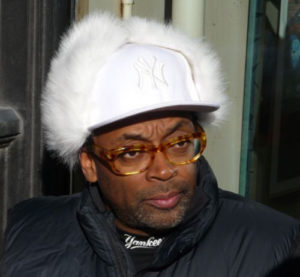 New Era agreed, and streetwear fashion has never been the same. It opened up an entire creative side of the brain that hadn’t been engaged. Shortly thereafter, New Era started running baseball hats that featured all MLB teams in different color ways and designs. A trend was born that is still burning bright over 20 years later. Other artists and celebrities would start wearing New Era 59/50 custom headwear in movies, videos or just on the streets themselves.
New Era agreed, and streetwear fashion has never been the same. It opened up an entire creative side of the brain that hadn’t been engaged. Shortly thereafter, New Era started running baseball hats that featured all MLB teams in different color ways and designs. A trend was born that is still burning bright over 20 years later. Other artists and celebrities would start wearing New Era 59/50 custom headwear in movies, videos or just on the streets themselves.
For Spike, it wasn’t about sending a message, or cultivating a look to be copied by millions, it was the outward expression of his fanaticism on full display. He wanted the hat to wear to the game and look like the freshest, fanatic of a fan in the stadium that night. When discussing the history of the sports fan apparel industry, all roads go through Spike.
Alyssa Milano
 Alyssa Milano first burst onto our T.V.’s as the tomboy girl next-door on Who’s The Boss, one of the biggest sitcoms of the late 80’s early 90’s. Milano gave us a glimpse of things to come, wearing a Yankees hat while playing Samantha Micelli, the no-nonsense teen from Brooklyn now living in the rich suburbs of Connecticut at the home of the single mother her father nannies for. (Side note, there were a run of 80’s sitcoms with nonsensical storylines that focused on the unrealistic power wielded by a nanny/butler/house keeper in the home of a wealthy family. See also Mr. Belvedere, Benson, Gimme A Break, Valerie, Charles In Charge and The Fresh Prince of Bel Air just to name a few.)
Alyssa Milano first burst onto our T.V.’s as the tomboy girl next-door on Who’s The Boss, one of the biggest sitcoms of the late 80’s early 90’s. Milano gave us a glimpse of things to come, wearing a Yankees hat while playing Samantha Micelli, the no-nonsense teen from Brooklyn now living in the rich suburbs of Connecticut at the home of the single mother her father nannies for. (Side note, there were a run of 80’s sitcoms with nonsensical storylines that focused on the unrealistic power wielded by a nanny/butler/house keeper in the home of a wealthy family. See also Mr. Belvedere, Benson, Gimme A Break, Valerie, Charles In Charge and The Fresh Prince of Bel Air just to name a few.)
 It was impossible to predict at that time that Milano would become the First Lady of licensed sports product. In 2006, the longtime Dodgers fan found herself underdressed -I know, tough to believe- and chilly at that night’s game, so she went to the team store looking for something cute to wear. She couldn’t find anything designed or cut specifically for women, only the same product from the men’s line in smaller sizes.
It was impossible to predict at that time that Milano would become the First Lady of licensed sports product. In 2006, the longtime Dodgers fan found herself underdressed -I know, tough to believe- and chilly at that night’s game, so she went to the team store looking for something cute to wear. She couldn’t find anything designed or cut specifically for women, only the same product from the men’s line in smaller sizes.
 Being an aggressive entrepreneur from a family of designers and seamstresses, Milano determined then to design and produce her own line of team licensed sports apparel, giving women something fashion-forward to wear while repping their favorite teams. The birth of her clothing line, Touch by GIII, soon followed, and the company is now nearing it’s 10th year offering attractive women’s apparel for the NFL, NBA, MLB, NHL, MLS, NASCAR and the NCAA.
Being an aggressive entrepreneur from a family of designers and seamstresses, Milano determined then to design and produce her own line of team licensed sports apparel, giving women something fashion-forward to wear while repping their favorite teams. The birth of her clothing line, Touch by GIII, soon followed, and the company is now nearing it’s 10th year offering attractive women’s apparel for the NFL, NBA, MLB, NHL, MLS, NASCAR and the NCAA.
Her designs in women’s team sportswear were a longtime coming. Fans reacted swiftly, and the women’s section in Pro Image Sports and beyond grew larger than they had ever been before. The Touch line, led to more women wearing team licensed gear. They no longer had to raid the closets of men to find something to wear to the game. Milano’s company has pulled off the rare accomplishment of having rights to produce apparel for every major American professional sports league, including the NCAA.
N.W.A
 N.W.A. were the first figures from pop culture who had people replicating their look in the streets and the suburbs. When the video for their signature hit, “Straight Outta Compton” was released, fans everywhere wanted the look of the most dangerous group in America. Which was fairly simple to replicate, wear a lot of black clothes and a fitted or snapback hat. Most commonly a black snapback for the then L.A. Raiders and L.A. Kings.
N.W.A. were the first figures from pop culture who had people replicating their look in the streets and the suburbs. When the video for their signature hit, “Straight Outta Compton” was released, fans everywhere wanted the look of the most dangerous group in America. Which was fairly simple to replicate, wear a lot of black clothes and a fitted or snapback hat. Most commonly a black snapback for the then L.A. Raiders and L.A. Kings.
They became the new rock stars. Every teenager is attracted to the spirit of rebellion, and no other act in music represented that more than N.W.A. The group quickly shot to stardom, then quickly dissolved almost as fast. Ice Cube and Dr. Dre obviously went on to multi-platinum solo careers, but they also continued to represent their brand of West Coast streetwear, which always included sports headwear.

Ice Cube is one of the many rappers closely associated with sports, but he continues to embody the Los Angeles sports fan more than any. He always wears a New Era hat in either his beloved Dodgers, Lakers or Raiders. He recently narrated a two-part 30-For-30 on ESPN detailing the vaunted rivalry in the 80’s between his Lakers and the Boston Celtics. Oh, and he also started his own 3-on-3 basketball league called the Big 3. His influence on the sports fan apparel space is still strong after 30 years.
Dr. Dre is your classic male sports fan. He finds one hat he likes and sticks with it. Dre hasn’t changed his style in years, but it is through his progenitors his influence is felt on what sports and fashion customers wear. Artists such as Snoop Dog, Tupac, Eminem, 50 Cent, The Game, and most recently, Big Sean & Kendrick Lamar, have all taken hip hop and the way the genre blends with sports fashion to the new generation of fans.
Allen Iverson
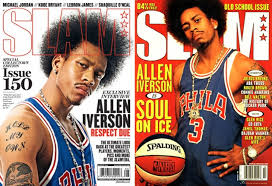 Allen Iverson wasn’t behind the design and production of any apparel. He didn’t need to in order to change the way the masses dressed. The marriage between hip hop and the NBA has been long and storied, and that story cannot be told without mentioning Iverson. For over three generations, rappers have wanted to be basketball players and conversely NBA players all dream of being rappers. The one has influenced the other heavily over the years, but no one quite as powerfully as Iverson.
Allen Iverson wasn’t behind the design and production of any apparel. He didn’t need to in order to change the way the masses dressed. The marriage between hip hop and the NBA has been long and storied, and that story cannot be told without mentioning Iverson. For over three generations, rappers have wanted to be basketball players and conversely NBA players all dream of being rappers. The one has influenced the other heavily over the years, but no one quite as powerfully as Iverson.
The iconoclast arrived in the league in 1996 as the first overall selection in the draft and found himself in a buttoned-up corporate NBA whose culture was curated by commissioner David Stern and created by Michael Jordan, Magic Johnson and Larry Bird. Iverson stood out as much for his off-court attire as he did for his frenetic scoring on the court. He was nothing if not real. At all times and in all places, for better or for worse, A.I. was himself.
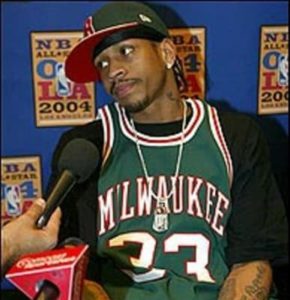 His diminutive size only added to his lore as an under dog dominating in a land of giants. He was relatable to kids everywhere, but to those who were living in underprivileged, impoverished circumstances similar to those Iverson escaped in Hampton, Virginia, he was a God. If he could overcome the odds so could they.
His diminutive size only added to his lore as an under dog dominating in a land of giants. He was relatable to kids everywhere, but to those who were living in underprivileged, impoverished circumstances similar to those Iverson escaped in Hampton, Virginia, he was a God. If he could overcome the odds so could they.
While MJ was wearing custom Italian suits that only the 1% could afford, Iverson cultivated a look that would be replicated by those in the streets because the remaining 99% could afford to dress like A.I. (Sans the iced out jewelry that is.) He started with the braids, which commonly comes with a du-rag. Then came the tattoos. Lot’s of them. He was always into baggy jeans and Timberland boots, as the two were signatures of any streetwear uniforms. A.I. quickly jumped on the New Era custom craze. Spike may have started the phenomena, but Iverson was the engine that delivered the look to the streets of America. He then put his twist on things by finishing off the look with a throwback NBA jersey from local Philadelphia company Mitchell & Ness, who had been a fledgling business for years prior to Iverson giving their jerseys his Midas touch.
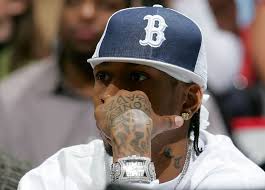 In the early aughts, A.I. had already done what many who came before him couldn’t, which was make Reebok’s cool. He was at the height of his powers, when one of the most iconic magazine covers in sports dropped. SLAM magazine had already adopted Iverson as their chosen son who shared the same ethos as the in-your-face publication. The issue that hit newsstands January 17, 2000 captured Iverson as his true self; braids picked out like they were on vacation off-court, donning a sparkling jewelry over a throwback Dr. J jersey. It was simultaneously an homage to the Philly forefather that paved the way for him, and a declaration that he would take things from there.
In the early aughts, A.I. had already done what many who came before him couldn’t, which was make Reebok’s cool. He was at the height of his powers, when one of the most iconic magazine covers in sports dropped. SLAM magazine had already adopted Iverson as their chosen son who shared the same ethos as the in-your-face publication. The issue that hit newsstands January 17, 2000 captured Iverson as his true self; braids picked out like they were on vacation off-court, donning a sparkling jewelry over a throwback Dr. J jersey. It was simultaneously an homage to the Philly forefather that paved the way for him, and a declaration that he would take things from there.
Soon, similar looks were found all around the country, but nowhere was it more common than on rap videos of the time period. Fabolous, Nelly and Ludicrous were all flag bearers of the look of the new millennium. There were countless others we will address in a future post.
Another iconic moment of A.I. wearing sports fan gear off the court was during a press conference in 2005 where he famously questioned rhetorically whether they were talking about practice. It is one of the most famous sports rants of all-time. In it, Iverson was wearing a gray New Era custom with an alt Boston logo of two red socks intertwined like stockings hanging over a mantel.
These influencers are far from the only ones who have had an impact on the team fan apparel we all wear and love. To celebrate the history of the licensed sports apparel industry, Pro Image Sports will take a closer look at other people and moments that changed the course of fan wear. There is more to come soon.
